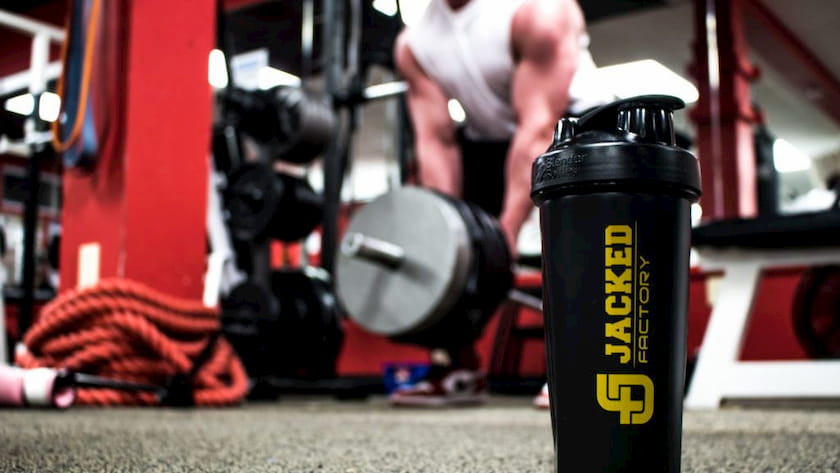Genetics can be the nightmare of a “hardgainer” looking to pack on muscle mass. The classic ectomorph body type is infamous for staying thin and lean to the point of being skinny despite attempts at proper diet and resistance training.
While genetics does play a primary role in what your body composition should look like, it by no means has the final say of what your results can be.
Many hardgainers blame their genetics when all along it’s been the nutrition and exercise program they so dearly cling to.
To get the size you want, putting on mass comes down to eating enough of the right foods, taking the right science-based supplements, and lifting heavy. It’s really that simple. There are no secrets, just hard and smart work.
Benefits of Being a Hardgainer
As a hardgainer, you have a natural tendency toward leanness. This is a huge advantage over the endomorph and mesomorph body types because it will require less work to achieve a shredded look once you pack on muscle mass.
Another benefit of being a hardgainer is that it won’t take much to notice your muscle gains. Adding 5 to 15 pounds of lean muscle mass on the body of a hardgainer will result in a very noticeable and dramatic change, meaning you will look super jacked!
Common Mistakes Hardgainers Should Avoid
Here are some examples of common mistakes made by hardgainers:
1. Training too often or too little
When you don’t give your body a chance to rest, you may risk over-training. Over-training can potentially rob you of your gains and result in injuries. However, If you don’t train enough, your muscles won’t receive the necessary stimulation for hypertrophy.
2. Training too light
Hypertrophy is stimulated by lifting heavy weight. You don’t want to sacrifice your form, but you should be training with heavy loads. Stick with heavy weight and 6 reps or less for 80% of your training!
The traditional 10-15 rep bodybuilding programs you’ve seen in your favorite muscle mag can be put on the back-burner for now, focus on lifting heavy.
3. Exercise selection not geared toward mass
Certain exercises work better than others do when it comes to building muscle mass. Compound movements such as the squat and deadlift are the key to packing on muscle. Don’t waste your time with too much isolation work, it won’t get the job done for you. 90% of your effort and time should be spent on compound movements.
4. Acute variables not geared toward hypertrophy
You need the right number of sets and repetitions in order to gain muscle mass. 4 to 6 sets of 3 to 6 repetitions have been shown to produce good results.
The Right Nutrition
Getting in enough food for growth doesn’t mean eating until you explode. As a hardgainer, you have the tools necessary to successfully take part in a clean bulk. To bulk properly, you want to aim for a moderate surplus of calories instead of the stereotypical eat-until-you-drop method.
The Layout
When done properly, a clean bulk should allow for a moderate weight gain between 0.5-1 pound per week (this number will be much smaller for well-trained individuals).
In order to achieve these numbers, you have to perfect your nutrition and caloric intake.
General guidelines are as follows:
- 1 gram of protein per pound of body weight per day
- 2 grams of carbohydrates per pound of body weight per day
- 0.4 grams of healthy fats per pound of body weight per day
If you find you’re still not gaining weight, despite your time at the gym and dedication of your meal planner, then you may want to consider increasing your caloric intake further by 150 to 300 calories.
Training Principles
Now that you have your nutrition set, it’s time to get your training program in order. Put simply: you need to lift heavy weight. Plain and simple.
It’s not just about lifting a lot of weight, however. It’s about lifting heavy weight with proper form, posture, and technique. You want to put on muscle mass, not put yourself on your back for weeks because you pulled something.
Muscle growth happens with progressive overload. Adding more plates to the barbell over time will maximize muscular hypertrophy. You may not be hitting 12-15 reps, but your muscles will actually grow, not just get a temporary pump.
The specifics of the program are less important than you may think, and you can customize it as you please. Just keep these key principles in mind:
- 80% of your training should be spent doing less than 6 reps with heavy weight on compound exercises
- Get at least 1 gram of protein per pound of bodyweight, and consume enough calories so that you are gaining weight
- Track your workouts and make sure that you are adding more resistance over time (progressive overload)
That’s it: train heavy, eat enough calories, get your protein in, and increase training volume over time.
Make no mistake about it, machines are not going to be your key to growth. If you haven’t already, you need to get familiar with free weights: barbells, dumbbells, and kettlebells. If it ends in “bells,” you are on the right track.
Training variables for a new gym-goer
Although the debate about ideal acute variables still rages on, scientific studies have determined the exact amount of sets, repetitions, and volume that is needed to achieve the ideal level of muscular hypertrophy and growth.
If you have never spent time with free weights, your muscles will not be accustomed to hypertrophy to the extent that an advanced lifter would be.
An ideal introduction program would consist of the following:
- 3 to 4 sets
- 8 to 12 repetitions
During each repetition, perform the tempo as follows:
- 4 seconds in the concentric phase (lifting the weight)
- 2 second in the isometric phase (pausing at the top of the movement)
- 1 second in the eccentric phase (lowering the weight)
Resistance load:
- 65% to 75% of your one-repetition maximum
Exercise selection:
Compound exercises such as the squat, bench press, and deadlift. Focus on perfecting your technique.
If you are familiar with the weight room, the variables are different:
- 3 to 4 sets
- 3 to 8 repetitions
During each repetition, perform the tempo as follows:
- 2 seconds in the concentric phase
- 0 seconds in the isometric phase
- 2 seconds in the eccentric phase
Resistance load:
- 75% to 85% of your one-repetition maximum.
Exercise selection:
Compound exercises such as the squat, bench press, and deadlift.
The Research
A number of studies have been completed to confirm the lift-heavy, get big theory. Researchers at Ohio University took 32 untrained male volunteers and had them lift weights for 8 weeks. The 32 men were divided into 3 groups:
- Group 1: 3 to 5 repetition range
- Group 2: 9 to 11 rep range
- Group 3: 20 to 28 rep range
After of the study, Group 1 had the most significant gains in muscle mass, strength, and endurance. (“Muscular adaptations in response to three different resistance-training regimens: specificity of repetition maximum training zones.” November 2002. Para. 1)
Another study, conducted at the American College of Sports Medicine, discovered that training programs should undergo a progression from 8 to 12 repetitions for novice lifters to a 1 to 6 rep range for advanced lifters with an emphasis on using heavy volume. (“American College of Sports Medicine position stand. Progression models in resistance training for healthy adults.” February 2002. Para. 1)
Arizona State University compiled a thorough review of over 140 other weightlifting studies! They concluded that when resistance training is performed at 80% to 85% of the lifter’s one-repetition maximum, muscle mass and muscular strength see the most improvement. (“A meta-analysis to determine the dose response for strength development.” March 2003. Para. 1)
The research has spoken: The best way to maximize your muscle is through 3 to 5 sets of 4 to 6 repetitions using heavy weight!
Tips and tricks
It can be easy and convenient to keep doing the same exercises with the same sets and repetitions for weeks, if not months. This is the quickest way for you to stop seeing progress in your gains. The way to avoid this is to change up your training program every 4 to 6 weeks.
For example, if you’re able to effectively perform more than 6 repetitions during one set, then increase your weight by 5 to 15 pounds. You must always be using a load that will force your body to grow & adapt. Your body will eventually adjust to the new weight, and you will increase it further.
When it comes to exercise selection, stick to the classics. The big lifts will guarantee the muscle mass that you want: squats, bench press, overhead press, deadlift, weighted dips, pull-ups, etc.
Stretching
Although it may be the least exciting part of an exercise routine, stretching is going to keep you loose, limber, and injury-free. Best of all, stretching accelerates recovery, making sure you can get back in the gym and keep pushing your progress.
Final Words
Don’t let “hardgainer syndrome” get you down. Follow the nutrition and training outlines above, stay dedicated, and you’ll see results within one to three months. Remember: you’ll only get as much as you put in.
References:
1.) Adams K, Cafarelli E, Dudley GA, Dooly C, Feigenbaum MS, Fleck SJ, Franklin B, Fry AC, Hoffman JR, Newton RU, Potteiger J, Stone MH, Ratamess NA, Triplett-McBride T; American College of Sports Medicine. “American College of Sports Medicine position stand. Progression models in resistance training for healthy adults.” ncbi.nlm.nih.gov.February 2002. Web.
2.) Alvar BA, Burkett LN, Ball SD. “A meta-analysis to determine the dose response for strength development.” ncbi.nlm.nih.gov.March 2003. Web.
3.) Campos GE, Luecke TJ, Wendeln HK, Toma K, Hagerman FC, Murray TF, Ragg KE, Ratamess NA, Kraemer WJ, Staron RS. “Muscular adaptations in response to three different resistance-training regimens: specificity of repetition maximum training zones.” ncbi.nlm.nih.gov.November 2002. Web.
4.) Clark, M.A., Lucett, S.C., Sutton, B.G. (2012). NASM Essentials of Personal Fitness Training. Baltimore, MD: Lippincott Williams & Wilkins.




Leave a comment
All comments are moderated before being published.
This site is protected by hCaptcha and the hCaptcha Privacy Policy and Terms of Service apply.